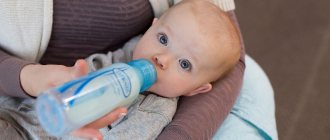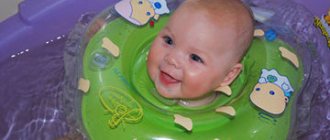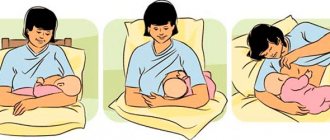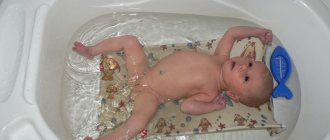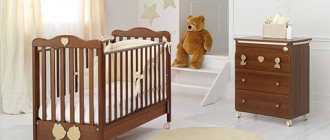How much sleep does a baby a few weeks old need to sleep? Why does a baby sleep well during the day, but does not fall asleep for a long time at night? In what position should a newborn sleep, and what should the room temperature be? How should you put a baby in his crib so that he doesn't wake up? Since these questions worry more than one young family, in this article we tried to answer them.
The question of how a newborn should sleep is not as simple as it might seem at first. The duration of children's sleep largely depends on the conditions that parents can create for their baby. During sleep, the infant gains strength, grows, and gains weight.
Some parents have no need to worry - their children sleep peacefully, do not toss and turn, delighting and touching everyone around them with their appearance. But there are also “sleepyheads” that create a lot of problems for their dads and moms, since their behavior differs significantly from what is expected.
Creating conditions for sleep
It is important to properly organize care and conditions for the baby. In the first months, he sleeps from seventeen to twenty-two hours - so you should take care of comfort.
You need to observe in what position the baby feels calmer, and adhere to the following recommendations:
- Maintain the air temperature in the room within 20-23 degrees.
- Keep humidity in the range of 55-75%.
- Choose a medium-hard mattress or crib.
- Eliminate sources of unpleasant odors (especially smoke) and sounds.
- Twilight in the room is better than bright light and flashing lights.
Temperature is very important for a newborn's sleep. If it is too hot or cold, he will not be able to fall asleep, he will begin to fidget, roll over from any position and cry. To maintain comfortable humidity, it is recommended to regularly carry out wet cleaning or purchase an air humidifier.
You should check whether the hardness of the bed or mattress is suitable. To do this, you need to lay the baby down and after an hour see if there are any dents on the surface: if there are none, the bottom of the crib or mattress is suitable. Lumps and folds are not allowed.
You should also remember to regularly ventilate the room: fresh air helps you sleep sounder and healthier. But the most important thing to remember is the poses.
What conditions are needed for a baby to sleep peacefully?
In order to have a restful sleep, you must first eliminate external stimuli.
This is what exactly these most comfortable conditions should consist of.
- The baby's bedroom should be well ventilated, and the temperature in the room should be between 20 - 22 degrees. If the weather permits, it is better for the baby to organize a daytime nap outside, in the fresh air. Oxygen-saturated air promotes more measured and restful sleep. Buy a device that allows you to determine the importance in the room - in a child’s bedroom it should be in the range of 50 - 60%.
- If your baby periodically wakes up every half hour in daylight, try organizing a semi-darkness for him in the bedroom. Cover your windows with curtains or blinds during the day. In the evening, remove any overhead lights by switching to a night light. Talk in a low voice, turn down the volume from the TV and close the window if city noises are coming from the street.
- Find the right mattress for your baby. Under no circumstances should the baby sleep on a soft mattress; his body should not sink or “drown” in it. It is better to buy two hard mattresses for sleeping - one for the crib, the other for the stroller. A baby does not need a pillow at all, up to a year. Hard surfaces help a growing child develop correct posture; on a soft bed, the baby can be harmed.
- Try to make your baby feel your presence even in his sleep. Do not go into another room while he is sleeping - he may feel a break in the connection with his mother and wake up. This connection is especially important in the first three months of his life. While the baby is small and light, it is generally better for the mother to carry him with her in a special sling, and in this position even do simple housework.
- If you decide to teach your baby to fall asleep in a crib, stay next to him until he falls asleep. Pet him, talk to him in a soothing tone, read him stories or sing a lullaby. It doesn’t matter what exactly you do, the main thing is that, even with his eyes closed, the baby feels your presence until a sound sleep overtakes him.
As common sense dictates, children are more likely to fall asleep the more you satisfy their physiological needs. At this age, the baby needs:
- There is. Make sure that when going to bed, the baby is fed and watered;
- walk. You need to walk your baby outside about twice a day. Do this right around the time he's napping;
- bathe. Evening swimming should be given special attention. By bathing the baby after an evening out, and then feeding and talking to him, you can easily “convince” him to sleep the required 6-7 hours at night;
- play. Don’t forget to talk to your baby, give him a massage, lisp with him, tell him a story or sing to him. Remember that we humans are social creatures, and your baby also needs communication with you, albeit not to the same extent as sleep or food.
Always take into account the general condition of the baby. Until about four months, babies, especially artificial ones, will have colic and tummy upsets. For those who are breastfed, it is a little easier in this regard. But all the same, for both of them it is necessary to carry out all preventive procedures, namely:
- do morning exercises;
- get massages;
- hold the baby upright after feeding so that he burps the air swallowed with milk;
- Place the baby on its tummy for a short period to remove gas from the little belly.
Correct Positions
It is ideal to find a compromise between sleeping together with the baby and sleeping in a crib: it is important for the child to feel the presence of his mother nearby, but if you sleep together, there is a danger of crushing him or not keeping track of his position.
The most common sleeping positions for a newborn include:
- on the back;
- on the tummy;
- on the side.
It is believed that it is safest and healthiest for a baby to sleep on his back. This way there is no pressure on the airways, nothing interferes with the movement of arms and legs - the baby can be left alone. The main thing is to spread your legs a little and bend them at the knees, and point your hands so that your fists point upward. You must turn your head to the side: now, if the baby burps, he will not choke. It is important to ensure that the head turns in different directions each time - this way you can avoid torticollis and curvature of the spine.
Sleeping on your back is allowed both at night and during the day. The main thing is that there are no contraindications to the position.
The position on the back is contraindicated if the baby has a runny nose: this makes breathing even more difficult. You cannot place a child in this way if he has muscle hypertonicity: he will constantly wake himself up with chaotic blows. This position is also prohibited for dysplasia and spinal abnormalities.
The baby can be placed on his tummy. This way he will fall asleep more soundly, learn to hold his head up faster and explore the room better.
It is advisable to leave him in this position for at least an hour a day, but you absolutely must not leave and stop watching! Children placed on their stomachs may bury their nose into the mattress and stop breathing. The position on the tummy helps to release gases faster and bring relief during colic, but you need to turn your head to the side and carefully smooth the mattress. It is forbidden to wrap the baby in blankets and diapers in this position.
Side sleeping positions are not recommended in the first months. Although this position speeds up the removal of gases and prevents suffocation from belching, the baby can roll over onto his stomach or scratch his face with his hands. Therefore, it is better to dress him in vests with sewn-up sleeves. To avoid the newborn turning over, you can lay him on his half side, placing blankets or bolsters under his back. This position should be avoided if the child has problems with the spine: this increases the load on him.
Accessories for healthy and safe baby sleep
To form the correct sleeping positions for a newborn, pediatricians recommend using special support devices. They are made in the form of pillows of various shapes. A prerequisite for all such products is that they must be made from natural, undyed fabrics with synthetic filler, since fluff or wool can cause allergic reactions and are more difficult to clean. The cover must be removable. Let's take a closer look at such devices.
Using a pillow
There are several types of these products:
- Butterfly pillow. It is a ring roller with a depression in the middle. This accessory will help support the baby’s head and neck in the correct position; it is especially recommended for babies with spinal problems. This type of product is classified as orthopedic.
- Inclined pillow. It has a small angle of inclination and helps maintain the correct position of the head and body during sleep in healthy children. An important point is that the product should be wider than the child’s shoulders. You can use such pillows at home.
- Stroller cushion. Designed to soften shocks when moving. It should be large, slightly raised and fairly rigid. The optimal type of filler for such a product is latex.
Knowing the features of each pillow, you can choose the best option for your child individually.
Sleep positioner
This is also a pillow, but tailored in a special way. On the sides it is equipped with special rollers of various diameters. They help maintain the baby’s body in the desired position during sleep, prevent falling forward or backward, and also reduce the risk of negative consequences if the child is put to bed immediately after eating.
Recommendations
It is better not to swaddle a child: this compresses the limbs, makes it impossible to move, which leads to weakening muscle tone and weakening blood flow to the brain, and as a result, development may slow down.
When breastfeeding (and bottle-feeding), you should not put the baby down right away; it is better to hold him upright for at least ten minutes, pressing him to your chest and resting his head on your shoulder. This way the nutritional mixture will be better absorbed and the baby will burp less.
It is extremely undesirable to place the child so that the head is higher than the feet. In the first months, only the horizontal position is correct
An incorrect position can lead to:
- skull deformations;
- excessive load on the spine;
- colic;
- sudden infant death syndrome.
If you have doubts whether your baby can sleep in a particular position, you should consult with pediatricians. Proper placement will avoid unpleasant consequences and help the little person grow up healthy and cheerful.
Article last updated: 05/25/2019
- Sleeping on your back
- On the tummy
- On the right or left side
- Conditions for proper rest of a newborn
After the child is discharged from the hospital, parents make sure that everything is done correctly. Caring mothers and fathers try to find out about sleep and feeding patterns even before birth. But not everyone knows how a newborn should sleep. You need to know how to properly place a newborn in a crib, this is necessary for his healthy growth and safety. Poses for children are not very different from those for adults, but they have their own characteristics.
Why do you need to change your baby's sleeping position?
The shape of a child's head changes throughout the year under the influence of internal and external circumstances. One of them is contact with a horizontal surface. Due to the fact that the baby lies all the time, the bones of his skull become flatter. If the mother puts the baby to sleep in different positions, the shape of the head changes evenly, maintaining the correct roundness. The situation is different when the baby spends too much time in the same position, for example, constantly sleeping on its side or back. In this case, the bones of the temporal or occipital region are completely aligned, and the head looks sloping on one side. This feature will disappear when the baby learns to walk. The time spent in a horizontal position will be reduced, and the beveled area will regain its previous roundness.
Sleeping on your back
Sleeping on the back is the most common position for a small child. In this position, the baby is as relaxed as possible, his legs are bent at the knees and spread to the sides, his arms are clenched into fists and located at the chin. Lying on his back, an infant can easily move his legs and arms.
However, you need to carefully observe the sleeping child. If he moves his arms very actively during sleep and this wakes him up, then it will probably be necessary to swaddle his upper body before bed.
Placing the baby on his back
is contraindicated for colic and hip dysplasia . If your baby is absolutely healthy, then this position will suit him perfectly.
Types of positions for healthy sleep
The correctly chosen sleeping position for a baby should be physiologically natural. We are talking about resting on your back. In this case, the baby bends his arms at the elbows with his fists up, bends his legs or spreads them to the sides.
Scientific research suggests that this position is the safest. It significantly reduces the risks associated with sudden infant death syndrome. However, this correct position also has its drawbacks. One of them is the likelihood of developing a flat back of the head, as well as the risk of developing the problem of a sloping and asymmetrical skull.
To prevent these unpleasant symptoms from appearing in the baby, parents are advised to monitor the timely change in the position of his head. During sleep, the baby's head is turned left and right, leaving him lying on his back. Soon he will get used to resting in this position and will turn his head in both directions without the help of his parents.
The supine position is contraindicated in the following situations:
- If your child is diagnosed with hip dysplasia.
- For muscle hypertonicity, which causes motor activity in the baby during sleep, expressed by flapping the arms. At the same time, the baby wakes himself up and gets scared. The way out of this situation is swaddling, but it is not suitable for every baby.
- If your baby suffers from colic caused by gas formation.
Suitable sleeping positions for a baby are positions that involve resting on the tummy or side. Parents are advised to observe their baby to find out how he sleeps more comfortably.
Currently, there is a lot of evidence that sleeping while lying on your tummy leads to dire consequences. We are talking about a death caused by sudden death syndrome in infants. No scientific evidence has been found for this.
And yet, it is better for mothers not to leave the baby until the age of three months (some pediatricians tend to say that until the age of one) to rest, sitting on the tummy, without parental supervision. The baby is not yet given full control of his body.
The baby can fall asleep with his nose buried in a mattress or pillow. The supply of oxygen will be blocked, causing the baby to stop breathing.
At the same time, falling asleep on his tummy, the baby experiences a feeling of security. This position is comfortable for him and he sleeps more peacefully. When falling asleep on your stomach, the back, neck muscles, and shoulder girdle are strengthened. In this lying position, the baby slightly raises part of the body below the waist, due to which there is an improved blood supply to the blood vessels of the brain.
The baby’s lower limbs are in the correct position from a physiological point of view; they are widely apart. This is an excellent preventive measure for the occurrence of hip dysplasia. When the baby’s body is pressed against a warm bed, it spends less heat, and therefore does not freeze.
In addition, the gastrointestinal system functions more actively when lying on the stomach, mother's milk is absorbed faster, and colic practically does not bother you. You should not swaddle your newborn if he prefers to sleep in this position.
A baby at the age of one month should be taught to lie on his stomach for at least a short period of time. This is an excellent prevention of colic. It is better to lay out the little one in this way for the day's rest.
The position on the barrel is the most common among infants, who can often spit up. You should place either a specialized cushion or a folded terry sheet under your child’s back. This way the baby won’t be able to roll onto its back.
In order for the baby to fall asleep in this body position, you need to turn him over on his side, lifting one leg towards his stomach and bending the other slightly at the knee. However, resting on the side is contraindicated for infants who have pathology of the hip joint. After all, the baby’s skeleton is still weak, and this sleeping position puts a lot of pressure on the joints.
The first time after birth, the toddler will try to take the position of the embryo, because it spent the previous months in this position. The baby, pulling his legs to his stomach, presses his hands to his chin.
But at almost one month of age, the newborn begins to move away from this position. If this does not happen, then there is a need to visit a specialist to exclude the condition of hypertonicity of muscle tissue in the baby.
The famous children's pediatrician, Dr. Komarovsky, suggests that adults do not interfere with the little one's rest in the most comfortable position for him.
On the tummy
Some pediatricians believe that sleeping in the stomach position has a very beneficial effect on the health of an infant, although not all doctors agree with this.
pros
In this position, the back muscles are strengthened, digestion is improved, and gases pass more easily. This position will improve the condition of the child with intestinal colic. Lying on his tummy, the baby turns his head to the side, the pelvic part is slightly raised, the legs are spread wide apart. This position strengthens the hip joints and increases blood flow to the brain.
Minuses
This position is considered dangerous because the child can bury his nose in the bed and suffocate. It should be noted that this statement is not entirely justified. If the child does not have any deviations in his development, then turning his head while laying him on his stomach occurs reflexively.
An important aspect is the design of a place for the baby to sleep. His crib should not contain bulky pillows, fluffy blankets, or soft toys. It is these objects that can end up in the child’s face and limit the flow of air.
It is better to place the baby on his stomach during naps. This way, household members will be able to watch the baby. And when the baby grows up, he will be able to lie on his tummy on his own exactly as many times as he wants.
What position should a newborn sleep in?
Many babies prefer to sleep on their back, but this position is considered the most unsuitable for newborns to sleep. The fact is that infants, especially in the initial months of life, often regurgitate milk after feeding, and if this happens in a supine position, the baby may choke.
You can try placing the baby on his stomach, but this position is not very suitable for lazy children. If the child absolutely does not want to turn his head to the side while lying on his stomach, this option is not for you.
Most babies from birth try to help themselves by avoiding an interfering pillow or mattress, but there are also little lazy ones who in no way react to such discomfort. At the same time, the position on the stomach is considered the most optimal for sleeping newborns, since it has several undeniable advantages:
- children sleeping in this position have more developed muscles; they begin to hold their head up, roll over on their side and crawl earlier than others;
- placing it on the tummy helps prevent colic and gas accumulation, which ensures sound and healthy sleep;
- burping after eating will prevent the baby from choking.
However, having chosen the main position to lie on the stomach, you must alternate the side of the head rotation, since otherwise the cervical vertebra may be slightly deformed.
Another good option is to lay the baby on his side; in this case, for greater comfort, you can place the baby in a folded diaper or a small cushion of medium hardness. This position also needs to be alternated: one day put the baby on the right side, the other on the left.
However, remember, no matter what position you put your baby to sleep in, he must be constantly monitored in any case. Periodically check the condition of the crib, the cleanliness of the bed linen, the absence of foreign objects near the baby, and of course, the condition of the sleeping baby
This way you will protect yourself and your baby from possible unpleasant consequences.
Periodically check the condition of the crib, the cleanliness of the bed linen, the absence of foreign objects near the baby, and, of course, the condition of the sleeping baby. This way you will protect yourself and your baby from possible unpleasant consequences.
On the right or left side
Sleeping on the right or left side has its pros and cons. This is perhaps the most common position in which parents put their newborn baby to sleep.
Lying on its side, the baby will never choke when regurgitating. It is necessary to place the child alternately on the right side and then on the left. Otherwise, torticollis and skull deformation may develop, which will subsequently be difficult to correct.
When laying the baby on his side, you need to put a special cushion or a rolled-up towel under his back so that the baby does not roll over onto his stomach or back.
Types of children's sleepwear
Usually, when answering the question of what to sleep in for a child under one year old, parents consider all possible options. So, it is customary to put babies in their usual home clothes. This could be a vest, romper, shirt, etc. For children under one year and older, sleeping bags, pajamas, and special sleeping overalls are becoming increasingly popular. Moreover, the overalls and sleeping bag will certainly cover not only the legs, but also the baby’s tummy and back. Moreover, changing a diaper in such clothes will be very easy. You don't even need to take off your overalls to do this.
Often, in search of an answer to the question of what to sleep in for a child under one year old, parents give preference to special sleeping bags. After all, they may also provide for the possibility of unhindered diaper changing. For older children, pajamas consisting of a sweater and pants are suitable.
Conditions for proper rest of a newborn
The position in which a child sleeps is of great importance. The conditions in which the baby exists play an even greater role. For proper rest, the baby must create favorable conditions.
7 rules for healthy sleep:
- There is no need to put the baby to bed immediately after feeding; it is better to wait a while and wait for him to burp. Otherwise, regurgitation will occur in your sleep, which threatens asphyxia.
- Properly organize your baby's sleeping place: it is not allowed to put a soft feather bed in the crib, put voluminous pillows and fluffy blankets, soft toys, etc. An infant does not need a pillow at all, and the sheets should be soft, without wrinkles, made from natural materials.
- The baby should sleep in silence and darkness. So his sleep will be deep, calm and long. To do this, you need to remove the TV and other noisy devices from the room where the child sleeps. The lights must be turned off, leaving only a night light on at night so that the mother can feed the baby and change his diapers.
- Maintain the correct microclimate in the room, ventilate more often and humidify the air.
- Before bedtime, give your child a bath with herbal teas that will help him relax and calm down. Chamomile or sage are excellent for these purposes.
- Don't take your baby into your bed. A breastfed baby can easily suffocate under your breast. Such cases, unfortunately, are very common. For the same reason, do not feed your baby while lying down. Unnoticed, you can fall asleep without removing your breast from your baby's mouth, which is very dangerous.
- The right thing to do is to teach your child to sleep in his own crib. For convenience, place it next to your bed by removing the side panel. This way you won’t have to get up at night, you just need to get up and get the baby out of the crib. And the baby will sleep more peacefully, hearing the calm breathing of his parents nearby.
There is no need to worry too much about what position your baby should sleep in. After watching your baby a little, you will understand which position he likes best. It is not possible to recommend any specific position for this age. The correct one would be one in which the baby sleeps soundly and nothing bothers him.
Baby sleeping on its side: harm or benefit
Is it harmful for a newborn to sleep on their back?
Sleep is very important for a child, since a lot of important processes take place in a sleeping baby’s body: growth hormone is produced, everything that happened during the waking period is analyzed and processed. In infants, growth and development occurs mainly during rest.
In order for the newborn to rest better, the mother bathes him in a bath with the addition of herbal infusions, gives him a light massage, turns on soothing music and gently strokes him. An important role for quality sleep and proper development of the baby is played by the position in which you put him to sleep.
Correct posture is the key to sound sleep
First you need to provide your baby with general conditions for a restful sleep:
- The lights should be dim. Light twilight helps the newborn rest and gives him the opportunity to calmly orient himself when he wakes up.
- There should not be any electrical appliances turned on in the room.
- The crib should not be placed near a window or right next to the door. Ensure there is no draft.
- It is also better to remove indoor plants from the room where the infant sleeps.
- The sleeping area should be wide enough and level.
- The temperature in the room should be approximately 21-23 degrees Celsius.
- Air humidity is at 60-70%.
- It is also advisable to ensure the room is soundproofed.
By following these recommendations, you will create the right conditions for your baby to have quality and sound sleep.
The main positions in which babies sleep have their advantages and disadvantages and are individual in nature. Small children can doze or sleep fully on their side, back, or tummy.
For each baby, it is important to choose the right resting position, taking into account the physiological characteristics of its development, as well as the preferences of the child himself.
The importance of position selection
The development of each baby has its own individual characteristics. But healthy sleep for all children is a very important element, which provides the opportunity for full growth and the development of immunity. Thanks to sleep, the energy and nerve cells that were spent while the baby was awake are replenished. The baby's mother, tired during pregnancy and the difficult postpartum period, enjoys every second of rest, and the baby himself actively grows and develops in his sleep.
Whether the baby will go through all stages of sleep (superficial, fast and deep) the required number of times depends on how correctly the baby’s sleeping position is chosen. If you analyze all the factors and place your baby correctly, he will be provided with good rest, develop correctly and quickly, strengthen his immunity and grow to the delight of his loved ones.
Sleeping positions and their effect on babies
The position in which you put your baby to sleep can affect his development and health. That is why it is important to choose a position that will be safe and comfortable for the baby.
Sleeping on your stomach
- This position allows the baby to feel a sense of security and comfort;
- it is noted that children sleep much more peacefully on their stomachs;
- the prone position strengthens the muscles of the back, shoulders and neck, which are necessary for developing the skills of turning over and crawling;
- when a child pulls his legs to his stomach while lying on his stomach, the lower limbs are slightly raised, and thus the blood supply to the brain improves;
- the separated legs are in a physiological position, thus reducing the risk of pelvic joint dysplasia;
- in a position on the stomach, body heat loss is reduced, the baby will not freeze;
- positioning on the stomach stimulates the gastrointestinal tract, the baby will be less bothered by colic;
- It is believed that sleeping on the stomach of a baby can cause SIDS (sudden infant death syndrome).
However, despite the above advantages, official medicine does not recommend specifically placing a newborn on his stomach. You can read more about sleeping on your stomach here. As they grow older, starting from 4-5 months, the baby will choose his own sleeping position.
Sleeping on your side
- Pediatricians prohibit placing newborns directly on their side; only babies older than a month can sleep in this position;
- the side position is recommended for babies prone to excessive regurgitation;
- in a position on their side, children pull their knees towards their stomach, this position promotes the passage of gas and reduces the pain of colic;
- if the baby sleeps on his side, change the side on which the baby is lying after each awakening to prevent the development of torticollis and other orthopedic problems;
- when a baby sleeps on its side, the load on the pelvic joints increases;
- from a position on its side, the child can uncontrollably roll over onto his tummy, bury his face in a blanket or mattress and suffocate.
Sleeping on your back
- The position on the back is considered the most physiological and is suitable for newborns;
- To prevent the baby from choking when regurgitating, you need to turn his head on its side when laying him down, changing sides after each awakening;
- the baby, lying on his back, is not limited in his movements, he can freely move his arms and legs, turn his head;
- The supine position is recommended by most pediatricians because this position reduces the risk of SIDS;
- a newborn lying on his back can wake himself up with the movements of his arms, so it is recommended to swaddle him loosely, leaving his legs free;
- If the baby has a stuffy nose, do not put him to sleep on his back, as it will be difficult for him to breathe; shift it so that the baby is on its side;
- The supine position is not recommended for children with pelvic dysplasia.
Newborn sleep
The baby needs proper care and comfortable living conditions. The baby spends 17-22 hours sleeping. Parents should take care of creating a favorable microclimate in the room and a comfortable sleeping place for the baby.
Conditions for sound sleep
The baby sleeps well if the necessary conditions are met:
- The temperature in the room is in the range of 20-23 ℃.
- The humidity in the room is 55-70%.
- The room is regularly ventilated.
- The bedroom is created in soft twilight (flickering lamps are not used).
- There are no unpleasant odors or noises in the home.
- The baby is not placed in the crib immediately after feeding; before going to bed, he is held in his arms in a column for several minutes. Thanks to this, the baby regurgitates excess air and is not tormented by colic during daytime or nighttime sleep.
- The baby's crib is equipped with a semi-rigid mattress. There should be no dents left on the sleeping place from the baby’s body. The mattress is correctly selected if its surface is instantly restored and lumps and folds do not form on it.
- The baby does not need a pillow. You should not place folded diapers under your baby's head. For convenience, raise the head of the crib slightly.
- There is no need to swaddle your baby. A baby wrapped in cloth cannot feel his arms and legs. Tight swaddling impairs blood circulation, which leads to a decrease in temperature and hypothermia. Feeling discomfort, the child becomes nervous and cries. A newborn feels good in a cotton onesie, a sleeping bag and a warm envelope with a zipper. These things do not hinder the child’s movements and retain warmth.
- Put the baby to sleep in a position that is comfortable for him.
- Practice independent and shared sleep.
Usually mothers try to find a compromise solution between sleeping together and resting the baby in the crib. The baby needs to feel the mother's warmth.
On the stomach
It is believed that infants who fall asleep on their stomachs become victims of sudden death syndrome. But doctors don’t yet have concrete evidence of this.
Sleeping on your stomach creates a feeling of safety and security. The position provides the child with comfort, he sleeps peacefully. This position of the newborn allows:
- strengthen the muscles of the back and neck;
- improve blood supply to the brain;
- take the legs into the correct anatomical position (with wide separation of the lower extremities, hip dysplasia does not develop);
- keep warm;
- activate the functioning of the digestive system (intestinal motility is normalized, milk is digested faster, gas passage is facilitated, colic goes away).
On the back
Parents only need to slightly correct the child’s position:
- spread your legs and bend them slightly at the knee joints;
- place the handles so that the cams look up;
- turn the head to the side (when burping, the baby will not choke).
When falling asleep on their backs, babies make sudden, chaotic movements. Children shudder in surprise and injure their faces with their nails. It is necessary to constantly trim the baby’s overgrown nail plates and wear clothes intended for sleeping.
Advertising:
The head is alternately turned left or right. Changing positions eliminates curvature of the spinal column and neck.
The baby must not be placed on its back:
- with a stuffy nose (breathing is difficult due to a swollen oropharynx);
- with muscle hypertonicity (chaotic movements wake the child);
- if the baby has hip dysplasia;
- for pathologies of the spine.
On the side
Sleeping on the side is the right position for babies who spit up frequently. Place a rolled up towel or blanket under the baby's back. The obstacle prevents the child from rolling over onto his back. The baby should be placed alternately on the right and left sides.
Head higher than body level
Various types of pillows are sold for newborns, including orthopedic ones. Some mothers are convinced that sleeping the baby in a position in which the head is higher than the body reduces regurgitation and relieves colic.
However, doctors warn that this position is not suitable for a baby’s daytime or nighttime sleep. When resting on a pillow for small children:
- the skull is deformed;
- the spinal column is bent;
- colic occurs;
- spinal pathologies develop.
In order for the child to develop a healthy spine and correct posture, he is put to sleep on a flat surface, with his head and body at the same level.
How to place your baby correctly?
Pediatricians recommend putting newborns to sleep on their side. Roll up the diaper and place it under the baby's back so that his body is slightly tilted to the side. This position reduces the risk that the baby will choke if he suddenly regurgitates, and does not place much stress on the baby's hip joints. This position seems to combine the positive aspects of sleeping on the side and on the back, and does not allow negative consequences to develop.
Instead of rolled diapers, you can use special positioners that will fix the baby in the required position.
Be sure to alternate the sides on which you place your newborn to sleep to prevent the development of torticollis. If you're worried about getting confused, you can "mark" the sides of the crib with a towel or hanging toy, repositioning them as you change baby's position.
When your baby is one month old, you can try placing him on his side. This position reduces the pain of colic and improves the functioning of the gastrointestinal tract. Once your baby can roll over confidently, he will likely start sleeping on his tummy.
Recommendations
- Do not put the baby to sleep in the crib immediately after feeding; carry him in your arms for a while so that he burps. This way, the baby’s sleep will become safe and calm, since the baby will not be disturbed by gas and colic.
- Don't swaddle your baby too tightly. Some mothers buy zippered sleeping bags for their newborn, which allow the baby to move freely while he sleeps. At the same time, he does not have the opportunity to touch his face with his hands when throwing himself up. In addition, in such an envelope the baby is guaranteed not to open up when he sleeps, which means you don’t have to worry that the baby will freeze in his sleep.
- When you cover a sleeping baby with a blanket, make sure that it is no higher than chest level and covers his legs. To be safe, you can tuck a blanket under the mattress.
How to organize co-sleeping with your child?
Organizing co-sleeping with a baby is not at all difficult. But all parents decide how to sleep with their child differently. Some do without a crib at all, placing the baby next to them from birth. Others practice co-sleeping only starting in the middle of the night, after the first feeding of the night. During the day and at night, the baby is left to sleep in his crib.
Co-sleeping can be understood as sleeping directly in the parent's bed, or in a crib with the side removed, moved towards the adult's bed.
There is also a “transitional” option for children older than one and a half to two years. The child is provided with a sleeping place “for growth”, usually a single bed, where one of the adults sleeps with the baby.
Sleeping together with a newborn frightens parents because the baby seems very small and fragile. This proximity of young dads is especially frightening. And for good reason: adults need to follow a number of conditions for healthy co-sleeping.
Both parents should not smoke. Alcohol, drugs, strong medications, sleeping pills and psychotropic drugs are prohibited. Co-sleeping can be dangerous if you are sick or feel overly tired. The baby must be full term and healthy. After feeding, you need to put the baby to sleep on his back. You should not swaddle or over-wrap your baby - he may overheat. The best option is light pajamas. Remember: the baby's body temperature rises from the mother's body heat. The temperature in the room should be approximately +22 if the baby is not yet 6 months old, and +18...+20 for children from six months old. The optimal indoor humidity is 50-60%. The room needs to be ventilated regularly. Avoid or use minimally strong-smelling cosmetics and perfumes
They mask the mother's natural odor, can make the baby's sleep restless and even make it difficult for him to breathe. It is important that an adult’s bed meets all the requirements for a place for a child to sleep (read more below). Pets do not belong in the bed where the baby sleeps. You cannot leave a baby unattended on an adult bed and put it to bed with older children who do not understand that a small child is defenseless and can suffocate. A possible danger for a child is sleeping with parents who are extremely obese. Breastfeed your baby. When feeding a baby up to 4-5 months, the mother should wake up to prevent possible suffocation of the baby or choking on milk.
Do not be afraid to infect your baby with any airborne infections. Sleeping together in this regard is no more dangerous than kissing and hugging.
Cot
When a newborn sleeps in a separate crib, the risk of accidental squeezing at night is completely eliminated. Moreover, if the child’s bed is located next to the parent’s bed, then the child still feels the closeness of the mother. At any moment she can reach the baby and calm him down with the touch of her hand. And you don’t need to go far for night feeding. Therefore, most pediatricians consider this to be the best option: a crib located next to the parent’s crib.
Baby cot next to parent's
There are 4 types of cribs for newborns:
- classic;
- cradles;
- transformers;
- playpens.
When choosing a sleeping place, first of all you need to be guided by how comfortable it will be for the child
A surface that is too hard will lead to improper development of the spine; a surface that is too soft can cause respiratory arrest.


